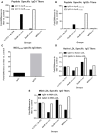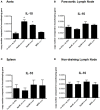Atheroprotective Vaccination with MHC-II Restricted Peptides from ApoB-100
- PMID: 24416033
- PMCID: PMC3873602
- DOI: 10.3389/fimmu.2013.00493
Atheroprotective Vaccination with MHC-II Restricted Peptides from ApoB-100
Abstract
Background: Subsets of CD4(+) T-cells have been proposed to serve differential roles in the development of atherosclerosis. Some T-cell types are atherogenic (T-helper type 1), while others are thought to be protective (regulatory T-cells). Lineage commitment toward one type of helper T-cell versus another is strongly influenced by the inflammatory context in which antigens are recognized. Immunization of atherosclerosis-prone mice with low-density lipoprotein (LDL) or its oxidized derivative (ox-LDL) is known to be atheroprotective. However, the antigen specificity of the T-cells induced by vaccination and the mechanism of protection are not known.
Methods: Identification of two peptide fragments (ApoB3501-3516 and ApoB978-993) from murine ApoB-100 was facilitated using I-Ab prediction models, and their binding to I-Ab determined. Utilizing a vaccination scheme based on complete and incomplete Freund's adjuvant (CFA and IFA) [1 × CFA + 4 × IFA], we immunized Apoe(-/-)mice with ApoB3501-3516 or ApoB978-993 emulsified in CFA once and subsequently boosted in IFA four times over 15 weeks. Spleens, lymph nodes, and aortas were harvested and evaluated by flow cytometry and real time RT-PCR. Total atherosclerotic plaque burden was determined by aortic pinning and by aortic root histology.
Results: Mice immunized with ApoB3501-3516 or ApoB978-993 demonstrated 40% reduction in overall plaque burden when compared to adjuvant-only control mice. Aortic root frozen sections from ApoB3501-3516 immunized mice showed a >60% reduction in aortic sinus plaque development. Aortas from both ApoB3501-3516 and ApoB978-993 immunized mice contained significantly more mRNA for IL-10. Both antigen-specific IgG1 and IgG2c titers were elevated in ApoB3501-3516 or ApoB978-993 immunized mice, suggesting helper T-cell immune activity after immunization.
Conclusion: Our data show that MHC Class II restricted ApoB-100 peptides can be atheroprotective, potentially through a mechanism involving elevated IL-10.
Keywords: T-cell; atherosclerosis; inflammation; vaccination.
Figures




Similar articles
-
Atheroprotective vaccination with MHC-II-restricted ApoB peptides induces peritoneal IL-10-producing CD4 T cells.Am J Physiol Heart Circ Physiol. 2017 Apr 1;312(4):H781-H790. doi: 10.1152/ajpheart.00798.2016. Epub 2017 Jan 13. Am J Physiol Heart Circ Physiol. 2017. PMID: 28087520 Free PMC article.
-
T cell-depleted splenocytes from mice pre-immunized with neuroantigen in incomplete Freund's adjuvant involved in protection from experimental autoimmune encephalomyelitis.Immunol Lett. 2014 Jan-Feb;157(1-2):38-44. doi: 10.1016/j.imlet.2013.11.001. Epub 2013 Nov 9. Immunol Lett. 2014. PMID: 24220208
-
A clinically applicable adjuvant for an atherosclerosis vaccine in mice.Eur J Immunol. 2018 Sep;48(9):1580-1587. doi: 10.1002/eji.201847584. Epub 2018 Aug 12. Eur J Immunol. 2018. PMID: 29932463 Free PMC article.
-
Lesion development and response to immunization reveal a complex role for CD4 in atherosclerosis.Circ Res. 2005 Mar 4;96(4):427-34. doi: 10.1161/01.RES.0000156889.22364.f1. Epub 2005 Jan 20. Circ Res. 2005. PMID: 15662027
-
Induction of skewed Th1/Th2 T-cell differentiation via subcutaneous immunization with Freund's adjuvant.Exp Dermatol. 2002 Apr;11(2):126-34. doi: 10.1034/j.1600-0625.2002.110204.x. Exp Dermatol. 2002. PMID: 11994139
Cited by
-
Pathogenic Autoimmunity in Atherosclerosis Evolves From Initially Protective Apolipoprotein B100-Reactive CD4+ T-Regulatory Cells.Circulation. 2020 Sep 29;142(13):1279-1293. doi: 10.1161/CIRCULATIONAHA.119.042863. Epub 2020 Jul 24. Circulation. 2020. PMID: 32703007 Free PMC article.
-
ApoB-Specific CD4+ T Cells in Mouse and Human Atherosclerosis.Cells. 2021 Feb 19;10(2):446. doi: 10.3390/cells10020446. Cells. 2021. PMID: 33669769 Free PMC article. Review.
-
Opportunities for an atherosclerosis vaccine: From mice to humans.Vaccine. 2020 Jun 9;38(28):4495-4506. doi: 10.1016/j.vaccine.2019.12.039. Epub 2020 Jan 19. Vaccine. 2020. PMID: 31964554 Free PMC article. Review.
-
Two decades of vaccine development against atherosclerosis.Nano Today. 2023 Jun;50:101822. doi: 10.1016/j.nantod.2023.101822. Epub 2023 Mar 31. Nano Today. 2023. PMID: 37860053 Free PMC article.
-
ATVB Distinguished Scientist Award: How Costimulatory and Coinhibitory Pathways Shape Atherosclerosis.Arterioscler Thromb Vasc Biol. 2017 May;37(5):764-777. doi: 10.1161/ATVBAHA.117.308611. Epub 2017 Mar 30. Arterioscler Thromb Vasc Biol. 2017. PMID: 28360089 Free PMC article. Review.
References
Grants and funding
LinkOut - more resources
Full Text Sources
Other Literature Sources
Molecular Biology Databases
Research Materials
Miscellaneous

